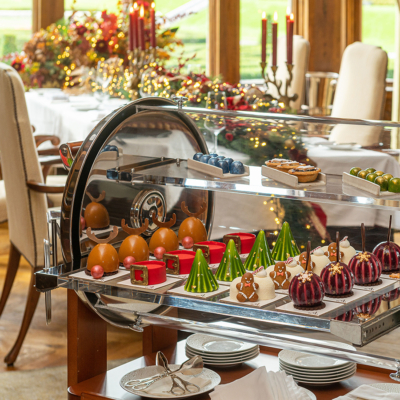Could coronavirus spell the end for sharing plates and help-yourself-style dining? LYNN ENRIGHT considers the serving options for the modern dinner-party host …
Coronavirus has changed everything – even the little things. The future of air kissing looks bleak. You might never again run for a lift, squeezing yourself in to a packed elevator car, just as the doors close. And heaving table filled with piled-high platters and dishes, ready for your guests to get stuck into – well, that could be called into question, too.
At our wedding three years ago, dinner was a Lebanese feast: a Notting Hill restaurant made enough food to feed at least 200 people (there were only 140 guests but Mo, the chef, insisted on the overabundance) and transported it across the city to Hackney. My family, who had travelled from Ireland, jostled for kibbeh and hummus with my husband’s family from Yorkshire and Manchester, who passed the serving spoons along to friends who had just flown in from Los Angeles. Looking back, it feels unfair to say that it was “unhygienic” but the set-up would certainly need some updating for the Covid era.
Tables laden with food, from which diners are encouraged to pick and choose, have long been an important part of dining culture. Service à la française, as it was known, was the default for aristocracy and royalty in Europe from the Middle Ages onwards. The joyous, celebratory spectacle was as valued as the actual quality of the food – and a heaving table indicated the largesse and good taste of the host. Service à la russe – where individual courses are brought to the table sequentially – started to replace service à la française in the homes of European aristocrats some time in the mid-19th-century. The major benefits were less waste and hotter food – and when the modern restaurant became commonplace, service à la russe was the norm.
Most formal restaurants continue to serve à la russe with courses (sometimes as many as 15 or 20 if it’s a tasting menu) brought to the table sequentially – but over the past decade or so, there has been a resurgence of service à la française. A buffet is no longer considered naff and sharing plates are par for the course at most casual restaurants. We opted to serve our wedding food that way because it’s cheaper than individually plated meals but also because it’s more fun and convivial – who knows what conversational fireworks will ensue after you ask a stranger to pass the baba ganoush? Now, however, as we all become a little more conscious about personal space and seek to eradicate the opportunity for double-dipping (as Seinfeld’s George Costanza was told as he dunked a half-eaten chip in the guacamole, “that’s like putting your whole mouth right in the dip”), it could be time to embrace service à la russe, even when hosting at home. So where to start?
Who knows what conversational fireworks will ensue after you ask a stranger to pass the baba ganoush …
One of the major appeals of service à la française is that it’s a way of serving a variety of foods. “Part of the shared plate phenomenon is, I think, a ‘friendly’ way of doing the tasting menus that some consider too precious,” says Cathy Kaufman, a chef-turned-food historian, and an expert in the structure of the meal. Unless you are going to serve up a tasting menu in your home – which, let’s face it, you’re not – you will need to incorporate that variety another way.
Alice, a friend who was the first person to invite me to a dinner party once lockdown was eased, has been considering the new etiquette carefully. There are individual bottles of hand sanitiser on her dining table and cloth napkins have been discarded in favour of paper ones. However, when it comes to the menu, she is reluctant to make too many changes lest she lose that variety. “The type of meals I usually make tend to be a bit of a jumble of things – not one defined ‘dish’,” she says. “I love sides.” So instead of doing away with a big spread, she serves each guest individually. “I put out a spread of multiple big dishes and then serve people according to what they want, a bit like a serviced buffet or school dinner lady,” she explains.
It would be a stretch to call Alice’s dinner-lady method service à la russe but it’s a hybrid that at least cuts down on the scrum that can occur when everyone starts piling up their plates at the same time.
Aside from variety, aesthetics will be a key concern for the host turning to service à la russe. Sharing plates allow for an impressive-looking table – nothing has to be too perfect as the colourful jumble is part of the appeal. Individual plates, however, demand more effort and attention. “My advice is not to overload plates,” says Kaufman. “Have a bit of asymmetry, but do not be too fussy or stressed about high-end restaurant perfection.”
Anna Haugh, the Dublin chef who runs Myrtle in Chelsea, admits that with perfectly plated food, “the host does a lot of sweating and a lot of running”. Her advice for serving à la russe at home? “Do a cold starter – do not do a hot starter, even a soup. With a cold or room-temperature starter, it’s done and plated before the guests arrive.” The same goes for dessert – she suggests individual chocolate mousses.
Your main course will be your main effort, she cautions. That’s when rushing around your kitchen is unavoidable. Do yourself a favour and have some elements cooked beforehand, she advises – a potato purée that you can put in the microwave is a good idea. And avoid green vegetables – they’ll be cold by the time they reach your guests.
Aisling McHugh, the co-owner of Roots Dinners, a pop-up dining experience that can be found at various farms and country houses around Ireland, has been considering the best way to serve food ever since the pandemic hit. People who are meeting regularly – close friends and family, say – will probably feel comfortable with à la française, she says; however, in a more commercial or formal setting, like a pop-up dinner or a wedding, that feels “finished for now”.
Creating pop-ups always involves compromises and creativity, working in spaces that might not be designed for dining. Adjusting to coronavirus is just another “restriction to work around”, says McHugh. “A lot of the time, those restrictions can make you more creative. It’s going to be different but that doesn’t mean it has to be worse.”
Service à la française creates a better atmosphere, she acknowledges, so as we adjust, it will be important to maintain that sense of fun. “The spectacle of food is important,” she says, “so you’ll have to find other ways to create that.”
“You could use a dessert trolley,” she suggests. “That way, you get individually plated food but there’s still an abundance and a sense of theatre.”
As Cathy Kaufman points out in an essay she has written on the subject, when service à la russe replaced service à la française, it wasn’t a clean break – there were variants of both throughout the era. And as service à la française made its comeback in the 2010s, it did so alongside service sometimes in the same restaurant. So serve your food in a way that makes sense for you and your guests – just remember to wash your hands, make sure your corkscrew is in good shape and to open the door with a smile.
LOVETHEGLOSS.IE?
Sign up to our MAILING LIST now for a roundup of the latest fashion, beauty, interiors and entertaining news from THE GLOSS MAGAZINE’s daily dispatches.










